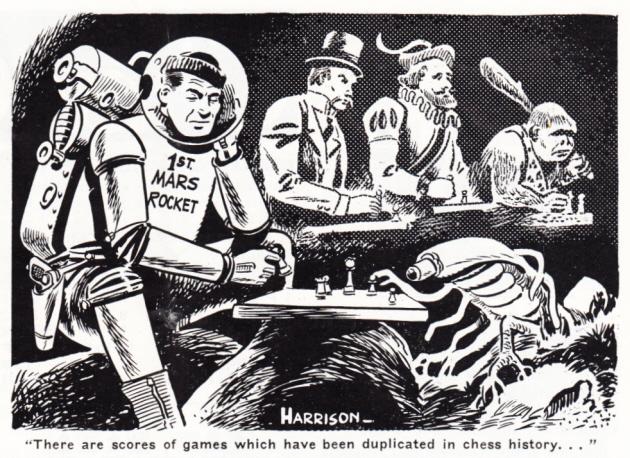
Edward Winter

Chess Review, March 1953, page 77 (C.N. 8257)
Identical chess games or themes do occur from time to time, and here we shall look at some of the less well-known cases of repetition – and fabrication.
First, a quiz question: name the naturalized American who won the following famous game:
1 e4 e5 2 Nf3 d6 3 d4 Bg4 4 dxe5 Bxf3 5 Qxf3 dxe5 6 Bc4 Nf6 7 Qb3 Qe7 8 Nc3 c6 9 Bg5 b5 10 Nxb5 cxb5 11 Bxb5+ Nbd7 12 O-O-O Rd8 13 Rxd7 Rxd7 14 Rd1 Qe6 15 Bxd7+ Nxd7 16 Qb8+ Nxb8 17 Rd8 mate.
The answer is not Paul Morphy (who was a native American) but Edward Lasker. The Morphy brilliancy against Count Isouard and the Duke of Brunswick was once repeated move for move by Lasker, as he reported on page 26 of the second edition of Chess Strategy:
‘The logical sequence of the moves in this game, as pointed out in the commentaries to it, is borne out by the curious coincidence that I once had the opportunity of playing a game in exactly the same sequence of moves, against a player to whom Morphy’s “brilliancy” was unknown.’
From page 276 of Ajedrez en Cuba by Carlos Palacio (Havana, 1960):
T. Marrero F. Melgarejo
Placetas, 1932
Evans Gambit Accepted
1 e4 e5 2 Nf3 Nc6 3 Bc4 Bc5 4 b4 Bxb4 5 c3 Ba5 6 O-O Nf6 7 d4 O-O 8 dxe5 Nxe4 9 Re1 Nxc3 10 Nxc3 Bxc3 11 Ng5 Nxe5 12 Qh5 h6 13 Rxe5 Bxe5 14 Nxf7 Rxf7 15 Qxf7+ Kh8 16 Bg5 Bf6 17 Re1 Resigns.
This seems to have a familiar look to it. Can a reader quote the same moves from another source?
(1364)
Carl-Eric Erlandsson (Lund, Sweden) has come to the rescue: the game was Steinitz v H. Devidé, Manhattan Chess Club, 1890.
(1459)
Here is another example of a repeated game-score. Page 240 of the December 1916 American Chess Bulletin had an item entitled ‘Chess League of Havana’:
‘... Among the most active of the organizations is the Campeonato de Ajedrez del Centro Gallego de la Habana, at the rooms of which, recently the following brilliant Evans Gambit was contested between E.B. de la Campa and S.R. Farinas.’
There followed the game-score. Black resigned at move 27. The timings were given. White: one hour 5 minutes; Black: one hour 35 minutes.
We need not give the moves here, as readers will find them in most collections of Morphy’s games (e.g. Löwenthal, pages 204-206 and Sergeant, page 170).
Under the heading ‘Reproduction of a Morphy Game’; the February 1917 American Chess Bulletin (page 39) reported:
‘Our attention has been drawn to the fact that the Evans Gambit between E.B. de la Campa and S.R. Farinas, of Havana, printed in the January [sic] number, is identical, move for move, with a blindfold game contested by Paul Morphy in New Orleans, the score of which is to be found on page 204 of Löwenthal’s collection. Mr de la Campa, who furnished the score of that game, was duly apprised of the state of affairs and since then we have received from him two letters, in neither of which he admits any intention to perpetrate a fraud upon the chess public. Evidently the matter created quite a stir in Havana, as he refers to the machinations of people hostile to him. He also states that he had requested Señor Farinas, an architect and a busy man, to write and substantiate him, but so far we have not heard from the latter. We make this statement of the case, believing we owe it to our readers.
It may be pointed out here that genuine coincidences of this sort are on record, and it is interesting to quote from Edward Lasker’s Chess Strategy, wherein, in connection with the famous blindfold game Morphy played against the Duke of Brunswick and Count Isouard at the Paris Opera House, the author refers to “the curious coincidence that I once had the opportunity of playing a game in exactly the same sequence of moves against a player to whom Morphy’s ‘brilliancy’ was unknown”.’
The Edward Lasker quote may be found on page 26 of his book (second, 1915 edition). The Bulletin’s reference to ‘Morphy’s famous blindfold game’ is an obvious mistake.
An interesting article, by ‘Cluen’, on a case of suspected plagiarism appeared on pages 158-160 of the April 1896 BCM (with a correction of the position on page 198 of the May issue). To reduce the complexities of the case to the bare bones: J.A. Blackman claimed that a three-mover by Dr S. Gold almost exactly reproduced a position that had arisen in a game played ‘some ten or 12 years ago between Major Walthall (now dead) and myself’. A rebondissement in the affair was the Major’s sudden revivification; he partially, and vaguely, substantiated Blackman’s story. The BCM writer was unconvinced, chiefly because the problem position looked so artificial. He appealed, apparently in vain, for the preceding moves of the ‘game’ to be published.
The controversy arose in Séguin’s New Orleans Times-Democrat column, where it was reported (6 October) that ‘Mr Ernst, our well-known local composer’ invented the felicitous expression ‘unconscious cerebral unification’.
(1532)
Morphy’s victory was in a blindfold game against P.E. Bonford at New Orleans in 1858. See, for example, page 350 of the biography of Morphy by David Lawson.
Yet another game that has a decidedly familiar look to it:
M. Eguiluz – Andrés Clemente Vázquez
Occasion?
Muzio Gambit
1 e4 e5 2 f4 exf4 3 Nf3 g5 4 Bc4 g4 5 O-O gxf3 6 Qxf3 Qf6 7 e5 Qxe5 8 d3 Bh6 9 Nc3 Ne7 10 Bd2 c6 11 Rae1 Qc5+ 12 Kh1 d5 13 Qh5 Qd6 14 Nxd5 cxd5 15 Bxd5 O-O 16 Rxe7 Qxe7 17 Qxh6 Kh8 18 Re1 Qd8 19 Bc3+ f6 20 Re8 Qxe8 21 Qxf6+ Resigns.
Our source is pages 45-46 of Un poco de ajedrez by Manuel Márquez Sterling (Mexico, 1883). The author comments: ‘This game places Señor Eguiluz on the same level as the Morphys and Anderssens.’
There are similarities between this finish and Morphy’s blindfold victory over P.E. Bonford (New Orleans, 24 March 1858 – see Lawson’s book, as referenced above).
(1662)
The New Orleans Times-Democrat of 10 September 1905 gives a drawn game, played in the tournament of the New Orleans Chess, Checkers and Whist Club, which was awarded a brilliancy prize:
Leon L. Labatt – Gilbert Dobbs
New Orleans, 1905
Evans Gambit Accepted
1 e4 e5 2 Nf3 Nc6 3 Bc4 Bc5 4 b4 Bxb4 5 c3 Bc5 6 d4 exd4 7 cxd4 Bb6 8 O-O d6 9 Nc3 Na5 10 Bg5 Ne7 11 Nd5 f6 12 Bxf6 gxf6 13 Nxf6+ Kf8 14 Ng5 Nxc4 15 Qh5 Kg7 16 Qf7+ Kh6 17 Qh5+ Drawn.
We note that these exact moves (extended with ‘17...Kg7 18 Qf7+=’) are given, unattributed, on page 247 of volume C of the Encyclopaedia of Chess Openings.
Since our topic is duplication (and the lack of attribution), we add the following, an example of how the chessgames.com website often copies material without giving any credit:
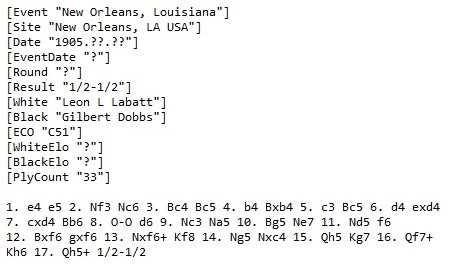

Pablo Morán (Gijón, Spain) draws our attention to the game Tolush-Aronson, USSR Championship, 1957: 1 d4 d5 2 c4 Nc6 3 cxd5 Qxd5 4 Nf3 Bg4 5 Nc3 Qa5 6 d5 O-O-O 7 Bd2 Bxf3 8 exf3 Nb4 9 a3 Nxd5 10 Na4 Resigns.
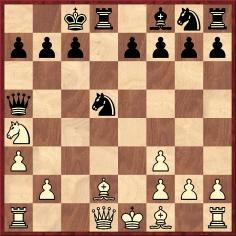
In the April 1987 CHESS (page 465) the identical moves were given as having been played in a game Alekhine-Nenarokov, Moscow, 1907. Our correspondent says that he has never seen this game ascribed to Alekhine, and asks for details.
See The Alekhine v Nenarokov Hoax.
Page 92 of Hugh Myers’ remarkably detailed 1986 book on 1 e4 Nc6 points out that Saulson v Phillips, Chicago, 1907 and Hartlaub v Meyer, Cologne, 1916 both went:
1 e4 Nc6 2 d4 e5 3 d5 Nce7 4 f4 d6 5 Nf3 Bg4 6 Nc3 Ng6 7 h3 Bxf3 8 Bb5+ c6 9 dxc6 Bxd1 10 cxb7+ Ke7 11 Nd5+ Ke6 12 f5 mate.
Next an example of a duplicated odds game, which was published on page 197 of the May 1903 BCM, taken from an article by Chigorin in Novoe Vremya.
N.N. – I.A. Zybin
St Petersburg Handicap Tournament, 1903?
(Remove Black’s f-pawn.)
1 e4 Nc6 2 d4 e5 3 dxe5 Nxe5 4 f4 Nf7 5 Bc4 Ngh6 6 Qd4 Be7 7 Oxg7 d5 8 Bxd5 Bf6 9 White resigns.
Thirteen years later the identical moves were played in a game at the City of London Chess Club between H. Bernstein and W. Winter, as reported on pages 394-395 of the December 1917 BCM.
From page 131 of the June 1909 American Chess Bulletin:
H. Menkes – L. Rosen
Rice Club Championship, 1909
Two Knights’ Defence
1 e4 e5 2 Nf3 Nc6 3 Bc4 Nf6 4 d3 Bc5 5 O-O d6 6 Bg5 h6 7 Bh4 g5 8 Bg3 h5 9 Nxg5 h4 10 Nxf7 hxg3 11 Nxd8 Bg4 12 Qd2 Nd4 13 Nc3 Nf3+ 14 gxf3 Bxf3 15 White resigns.
The magazine remarks: ‘The entire play is “book”, which fact, however, makes the game none the less interesting.’
For some reason these moves are also said to have been played in a game between Dubois and Steinitz, London, 1862 (e.g. pages 8-9 of 200 Miniature Games of Chess by J. du Mont), even though that game developed along altogether different lines after 9 h4 Bg4 10 c3 Qd7.
On the other hand, the complete game above appears again on page 114 of Chernev’s The 1000 Best Short Games of Chess under the heading ‘Grabill v Mugridge, Los Angeles, 1932’ and with the statement that the win is based on a brilliant piece of analysis by Steinitz.
(1750)
For further details see Confusion.
The following game was published on page 13 of the Chess Player’s Chronicle, 1870:
Mr R.T.P. – Mr Young
‘Chess at the Antipodes’
Muzio Gambit
1 e4 e5 2 f4 exf4 3 Nf3 g5 4 Bc4 g4 5 O-O gxf3 6 Qxf3 Qf6 7 e5 Qxe5 8 d3 Bh6 9 Bd2 Ne7 10 Nc3 c6 11 Rae1 Qc5+ 12 Kh1 d5 13 Qh5 Qd6 14 Bxd5 cxd5 15 Rxe7+ Kxe7 16 Nxd5+ Kd8 17 Bb4 Qg6 18 Qe5 Nc6 19 Be7+ Kd7 20 Qc7+ Ke6 21 Qd6+ Kf5 22 Ne3 mate.
A note at the end reads: ‘A brilliant termination, worthy of the Gambit. It is a remarkable fact we have again to notice an instance in which the same game has been played more than once by different persons. This very game is given move for move in the Chess Player’s Chronicle, for 1850, page 169.’
The magazine’s vague source of the R.T.P. victory version is ‘an extract from an Australian newspaper, with which we have been favoured by a correspondent’.
(1751)
The subject of identical games is raised on page 82 of the January 1989 Chess Life, where a reader, George Gallagher, points out a pair in the Oxford Encyclopedia of Chess Games: Lasa v Jaenisch, Berlin (?) 1842 and Morphy v Löwenthal, London 1858 (page 77 and page 268 respectively).
In a slovenly reply Larry Evans, ignoring all that has appeared on the subject in C.N., adds only Marshall v Burn, Paris 1900/Mentges v Gitzen, 1933, as given on page 119 of Assiac’s The Pleasures of Chess.
If Mr Evans refuses to do his work properly, why does Chess Life keep him?
(1752)
There follows a specimen from correspondence chess:
P.L. Williams – H. Falconer
Correspondence game, 1946
Scotch Gambit
1 e4 e5 2 Nf3 Nc6 3 d4 exd4 4 Bc4 Bc5 5 Ng5 Nh6 6 Nxf7 Nxf7 7 Bxf7+ Kxf7 8 Qh5+ g6 9 Qxc5 d6 10 Qc4+ Be6 11 Qb5 Ne5 12 f4 Bc4 13 Qb4 Qh4+ 14 White resigns.
A game between Greville and Harrwitz (Paris, 1845) had been identical, except that White played 10 Qd5+.
Source: Chess World, 1 March 1947, page 55.
From pages 64-67 of How Purdy Won (Cammeray, 1983) by C.J.S. Purdy, F. Hutchings and K. Harrison:
F.L. Vaughan – C.J.S. Purdy
Correspondence, -1946
Grünfeld Defence
1 d4 Nf6 2 c4 g6 3 Nc3 d5 4 Bf4 Bg7 5 e3 c5 6 dxc5 Qa5 7 cxd5 Nxd5 8 Qxd5 Bxc3+ 9 bxc3 Qxc3+ 10 Ke2 Qxa1 11 Be5 Qc1 12 Bxh8 Be6 13 Qxb7 Qc2+ Drawn.
Purdy comments:
‘This game finished in 1946. Eight years later the same game occurred in the crossboard grandmaster tourney of Bucharest 1954, Filip v Pachman. And ten years after that, Pachman played it with Black again, this time against Darga, in the Interzonal, Amsterdam 1964. In the last round of the same tourney it occurred yet a fourth time, in Berger v Bilek.’
(1860)
Shortly after the spectacular miniature J. Polgár v Angelova had been played at the 1988 Thessaloniki Olympiad, Richard Reich (Fitchburg, WI, USA) pointed out to us (see C.N. 1806) that the whole game had been given on page 44 of the 1984 book The Anti-Sicilian: 3 Bb5 (+) by Y. Razuvayev and A. Matsukevitch, where mention is made of ‘Levchenkov-Eganian, USSR, 1978’.
Sometimes a master has the opportunity to play the identical game twice:
J.H. Blackburne – Two unnamed players
Hastings and Eastbourne, 1894
French Defence
1 e4 e6 2 d4 d5 3 Nc3 Nf6 4 Bg5 Be7 5 Bxf6 Bxf6 6 Nf3 O-O 7 Bd3 Nc6 8 e5 Be7 9 h4 f6 10 Ng5 fxg5 11 Bxh7+ Kxh7 12 hxg5+ Kg8 13 Rh8+ Kxh8 14 Qh5+ Kg8 15 g6 Rf5 16 Qh7+ Kf8 17 Qh8 mate.
On page 179 of Mr Blackburne’s Games at Chess J.H.B. wrote: ‘A curious fact about this game is that move for move I played it exactly in the same way twice in one week, once at Hastings and once at Eastbourne, in the year 1894.’
A series of items from the early years of C.N.:
Wanted: the longest number of moves for which two games have independently followed each other. We shall open the bidding here with the 22nd and 24th world championship match games between Capablanca and Alekhine in 1927, which were identical for 25 moves.
(304)
Paul Timson (Whalley, England) quotes Kasparov-Timoshenko and Kasparov-Dorfman, USSR Championship, 1981, which were identical up to Black’s 30th move. The games were played on consecutive days (rounds 13 and 14), and Kasparov won both.
(379)
On page 33 of The First Grand Open by R. Gillman and J. Hawkes it is noted that D.A. Fennelly played the same 18-move draw against two opponents (S. Carr and N.B.K. Gill). ‘We wonder if this is the first time that a game has been recorded twice in the same tournament’, remark the authors.
(508)
René Olthof (Rosmalen, the Netherlands) writes:
‘Zurich, 1959 also featured two games which were identical: Unzicker v Gligorić and Unzicker v Ólafsson.’
We would be interested to know how much time Unzicker consumed on the second encounter.
(676)
René Olthof sends us copies of games played in the NBC Volmanic anniversary tournament (a correspondence event). D. Orseth played the identical game as Black against both J.D.H. Brugman and W.J. Mooij, except that the former encounter had one extra move, 32...Qd4, before the draw was agreed. In the same event H.B. Sarink (Black) had identical games against Brugman and Mooij up to move 51, winning both in due course. ‘It is painfully obvious that Mooij and Brugman worked together’, comments Mr Olthof. ‘Another example of C.N. 508, of course, is Chandler/Nunn v Karpov, Vienna Open, 1986.’
(1477)
Also from René Olthof:
‘The game Chandler/Nunn-Karpov has been played at least five times by Karpov (also: Ljubojević-Karpov, Brussels SWIFT, 1987; A. Sokolov-Karpov, Bilbao, 1987, Hübner-Karpov, Tilburg, 1986 (and most probably on many more occasions).)
Your “Volmanic anniversary tournament” is peculiar. It was the NBC (Dutch Federation of Correspondence Players) 15th anniversary tournament sponsored by the software company Volmac (which also sponsors a team, Rotterdam, in the Dutch over-the-board team championship, featuring Timman and Korchnoi on top board).
Portisch-Nunn, Budapest, 1987: the third and fifth games of their play-off match beat them all: the same game during an event by the same players.’
(1508)
The individual phases of chess also give rise to bizarre repetition, an example being the opening moves of two games played on adjacent boards in the fifth round of the Hastings, 1922-23 tournament (30 December 1922):
1) Rubinstein v Condé: 1 d4 d5 2 Nf3 e6 3 e3 Nf6 4 Bd3 Bd6 5 O-O Nbd7 6 Nbd2 O-O 7 e4 dxe4 8 Nxe4 Nxe4 9 Bxe4 Nf6 10 Bd3 b6 11 Bg5 Bb7 12 Qe2 Be7 13 Rad1.
2) Yates v P.W. Sergeant: 1 e4 e6 2 d4 d5 3 Nc3 dxe4 4 Nxe4 Nd7 5 Nf3 Ngf6 6 Bd3 Nxe4 7 Bxe4 Nf6 8 Bd3 Be7 9 O-O O-O 10 Qe2
Two distinct openings have led to identical positions one after 13 moves but the other after 12.
[Another case, mentioned in C.N. 2100, is on page 154 of Kings, Commoners and Knaves.]
Middle-game combinations can also be the subject of duplication, but here too one must be wary, since chess chroniclers often write n’importe quoi. On page 39 of the March 1992 Europe Echecs, Sylvain Zinser asserted that the following position had occurred in ‘Blackburne v Gifford, England 1874’.

The finish is given as 1 Qxc6+ Kxc6 2 Ne5+ Kc5 3 Nd3+ Kd4 4 Kd2, and mate next move by 5 c3 is unavoidable. But this position bears an uncanny resemblance to the following, widely published in chess literature:
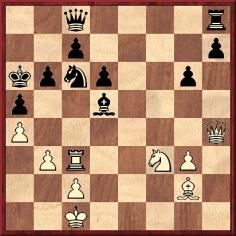
Kasparyan v Manvelyan, simultaneous display, USSR, 1936
White won with 1 Rxc6 Bxc6 2 Qc4+ Kb7 3 Qxc6+ Kxc6 4 Ne5+ Kc5 5 Nd3+ Kd4 6 Kd2 Qe6 7 c3 mate.
[For further information on the above pair of positions, see C.N.s 5155, 5156, 5163, 5180, 5193 and 8127.]
Few combinations are unique, and there are often ‘variations on a theme’. A strange example is the so-called ‘Game of the Century’ won by the 13-year-old Fischer against Donald Byrne in the 1956 Rosenwald Trophy Tournament. It was a Grünfeld Defence, the climax to which came when Black ignored the attack on his queen by the white queen’s bishop and played ...Be6, with overwhelming threats to the white king at f1. Yet all that is exactly what also happened in the following game, played the year before Fischer was born:
H.R. Russner – Carl Walcker
Cracow-Warsaw match, Warsaw, 28 June 1942
Grünfeld Defence
[Note: the above details contain corrections based on the subsequent C.N. items 7926, 7930, 8085, 8265 and 9427.]
1 d4 Nf6 2 Nf3 g6 3 c4 Bg7 4 Nc3 d5 5 cxd5 Nxd5 6 e4 Nxc3 7 bxc3 c5 8 Bc4 O-O 9 h3 cxd4 10 cxd4 Nc6 11 Be3 Qa5+ 12 Bd2 Qa3 13 Rb1 Nxd4 14 Bb4 Nxf3+ 15 Kf1
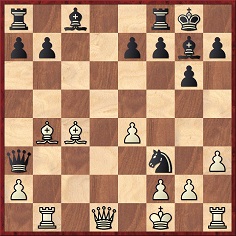
15...Be6 16 Be2 Qxa2 17 Bxf3 Rfd8 18 Qe1 Rac8 19 g4 b6 20 Bxe7 Bc3 21 Qc1 Rd2 22 Bh4 Bd4 23 Qe1 Rcc2 24 Rh2 Bc4+ 25 Kg1 Rxf2 26 Rxf2 Rxf2 27 Bxf2 Bxf2+ 28 Qxf2 Qxb1+ 29 Kh2 Qa2 30 Qxa2 Bxa2 31 White resigns.
An addition on page 202 of Kings, Commoners and Knaves
An earlier case was 18…Be6 in the game E. Polyak v D. Bronstein, Kiev, 1938. See pages 71-73 of The Sorcerer’s Apprentice by Bronstein and Fürstenberg.
At the Central Café in Vienna on 2 December 1914, Richard Réti won a miniature against Dunkelblum (‘of Cracow’):
Richard Réti – Dunkelblum
Vienna, 1914
Three Knights’ Game
1 e4 e5 2 Nf3 Nc6 3 Nc3 Bc5 4 Nxe5 Nxe5 5 d4 Bxd4 6 Qxd4 Qf6 7 Nb5 Kd8 8 Qc5 Resigns.
The game was published on page 153 of the July-August 1915 issue of the Wiener Schachzeitung and has become an anthology piece. White’s seventh and eighth moves were awarded two and three exclamation marks respectively, and the conclusion is certainly a neat example of the double threat (to c7 and f8). Yet remarkably, the identical moves had been played before, and although the earlier game had been won by none other than Capablanca, it was promptly forgotten. The occasion was a simultaneous display in Washington on 6 January 1909. Missing the main threat, the young Cuban’s opponent, E.B. Adams, played 8...Nc6, which was naturally answered by 9 Qf8 mate.
(Inside Chess, 1992)
From page 272 of Chess Explorations:
On page 242 of the June 1979 CHESS we published Emanuel Lasker v Powell, simultaneous exhibition, Liverpool, 1895, a game which saw play similar to Botvinnik’s against Capablanca [AVRO, 1938]. Lasker too offered the sacrifice Bb2-a3 with the aim of diverting the enemy queen, which was blocking a white passed pawn at e6.
On the subject of duplication, Alec McGowan (Waterloo, Canada) writes in with reference to the following game given in C.N. 61:
G. Grohmann – Ludwig Engels
German championship, Aachen, 25 May 1934
Queen’s Gambit Declined
1 d4 d5 2 c4 e6 3 Nc3 c6 4 e3 Nd7 5 Nf3 f5 6 Bd3 Qf6 7 Qc2 Nh6 8 O-O Bd6 9 cxd5 exd5 10 e4 fxe4 11 Bxe4 dxe4 12 Nxe4 Qf8 13 Re1 Kd8 14 d5 c5 15 b4
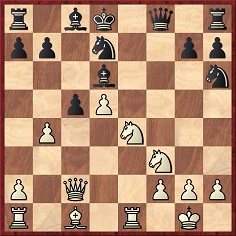
15…Ng4 16 Bg5+ Ngf6 17 Rac1 b6 18 Nd4 Ne5 19 Nxd6 Qxd6 20 Rxe5 cxd4 21 Bf4 d3 22 Qd2 Qd7 23 d6 Re8 24 Rc7 Qg4 25 f3 Qg6 26 Rg5 Re2 27 Rxg6 Rxd2 28 Rgxg7 Rc2 29 Rcf7 Ke8 30 Rxf6 d2 31 Re7+ Kd8 32 Rf8 mate.
Sources: Wiener Schachzeitung, July 1934, pages 200-202 and the Australasian Chess Review, 30 August 1934, page 238.
Our correspondent has noticed that many years later Grohmann won the following strikingly similar game, which was published on page 10 of the 1/1951 Deutsche Schachblätter:
G. Grohmann (Eckbauer) – Voelker (Pankow)
Berlin League Match, 1950
Queen’s Gambit Declined
1 d4 d5 2 c4 e6 3 Nf3 c6 4 e3 Nd7 5 Bd3 f5 6 O-O Bd6 7 Nc3 Qf6 8 Qc2 Nh6 9 cxd5 exd5 10 e4 dxe4 11 Bxe4 fxe4 12 Nxe4 Qf8 13 Re1 Kd8 14 d5 c5 15 b4 (See the diagram above.) 15...b6 16 Nd4 cxd4 17 Qc6 Bxb4 18 Bg5+ Nf6 19 Nxf6 Nf7 20 Ne8+ Be7 21 Qc7+ and mate in two moves.
(2769)
Note: Our 1992 article on Duplication in CHESS was included on pages 198-202 of Kings, Commoners and Knaves. Since then, databases have naturally made it possible to find innumerable examples of duplication at the touch of a button.
To the Chess Notes main page.
To the Archives for other feature articles.
Copyright: Edward Winter. All rights reserved.